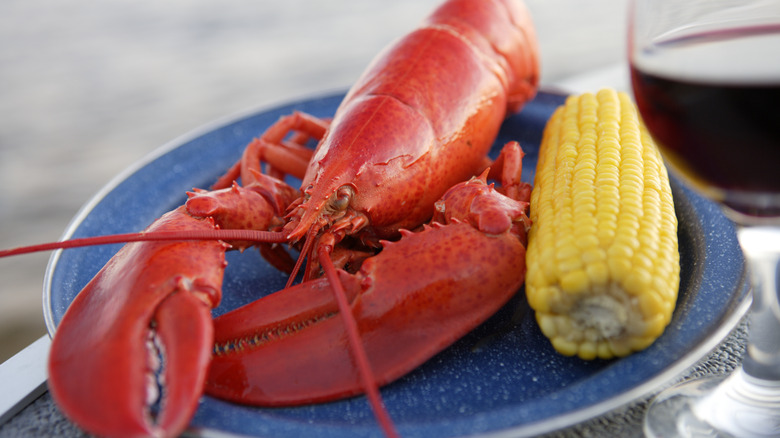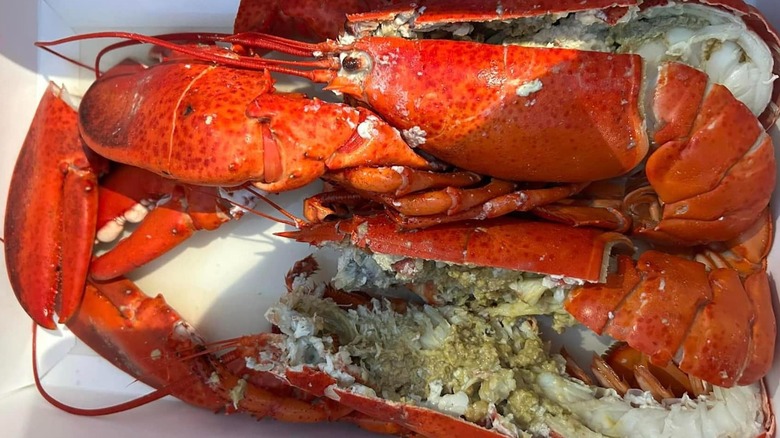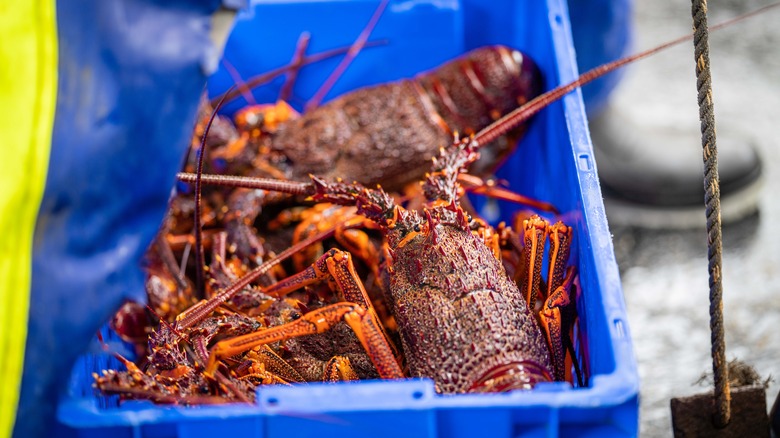What Is The Green Stuff You See In Lobster?
Have you ever noticed a bright green paste in the center of your home-prepared lobster? If so, you've encountered tomalley. This soft, edible substance is technically known as the hepatopancreas, an organ found in crustaceans like lobsters, crabs, and shrimp. It functions similarly to the liver and pancreas organs by secreting digestive enzymes that helps the organism with food absorption. But, to lobster connoisseurs, tomalley is more than anatomy — it's a rich flavoring that can enhance the taste of lobster meat or be used as an additive in mouthwatering sauce recipes.
Tomalley has a salty, buttery flavor alongside a funky umami note. Its texture is similar to a thick chowder or whipped guacamole, and its color brightens from a beige-yellow hue to a vivid yellow or green after it's cooked within the lobster's body. While it may sound unappetizing to many, this delicacy is prized in modern-day New England, where lobster is a-plenty, and has roots tracing back to the 17th-century pre-colonial Caribbean islands.
The word tomalley itself is a Caribbean coinage — the communities based in the region would create a sauce known as toumalin. Tomalley was introduced to the Western world through the trade routes that brought several varieties of rum and molasses to the States.
How to use tomalley in culinary preparations
Purists may claim that the best way to eat tomalley is to do so in a straightforward method, by scraping the innards with a spoon and eating them alongside the flesh of the lobster. A slightly more curated option involves spreading the flavorful paste on a piece of bread or toast to accompany the meal. However, tomalley can also be used as an unlikely seasoning in a variety of dishes, and you may not even know when it's present in your meal.
A simple sauce can be made by blending the tomalley with butter, salt, and a dash of wine, while more complex recipes can be found for various nuanced sauces. It also adds body and a smooth texture when blended into broths and is a common additive in dishes such as chowder due to its complimentary seafood flavor. For a drier and textured preparation, tomalley can be mixed with breadcrumbs, herbs, and seasonings for an umami-rich accent in your favorite stuffing recipe.
Some recipes further intensify the flavors of tomalley by pairing it with roe, or the fish eggs found in female lobsters and other marine creatures. The concentrated roe flavor adds even more depth to a dish and can also act as a binder in certain recipes. No matter how you prepare tomalley, it often has the same effect — adding the iconic flavor of lobster into your dish and onto your palette.
Is tomalley safe to eat?
Tomalley can be quite polarizing — some find the substance to be the créme de la créme of shellfish, while others pass on it based on the unusual texture and funkiness. Regardless of which side of the line you fall on, there are important food safety considerations to keep in mind. Since the lobster's hepatopancreas is meant to clear bacteria and dead cells from the lobster's body, issues arise if the animal was exposed to contaminated waters.
When there's a red tide (meaning harmful algae bloom) in the ocean, lobsters dine on contaminated plankton that may contain Paralytic Shellfish Poisoning (PSP), which, according to the Washington State Department of Health, can cause human illness and even death in some cases. Unfortunately, PSP can't be removed by cooking or freezing the lobster. Additionally, in 2008, the FDA released a warning advising against eating lobster tomalley sourced from New England waters at that time While some shellfish beds were closed down, there hasn't been another government update since then — or any other warnings for that matter.
This leaves consumers wondering if it's, in fact, currently safe to indulge in the delicacy. As with most things, many agree that, when eaten in moderation, adverse side effects can be avoided. Make sure you source your lobster from reputable companies that regularly monitor and track the waters their supply comes from. With these safety considerations in mind, if you can get your hands on a safe source of tomalley, it's worth it to savor the rare treat.



